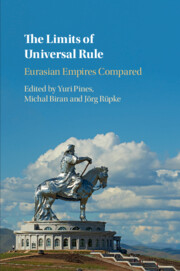Book contents
- The Limits of Universal Rule
- The Limits of Universal Rule
- Copyright page
- Contents
- Maps
- Figures
- Contributors
- Abbreviations
- Preface
- Introduction
- 1 From the Mediterranean to the Indus Valley: Modalities and Limitations of the Achaemenid Imperial Space
- 2 Limits of All-Under-Heaven: Ideology and Praxis of “Great Unity” in Early Chinese Empire
- 3 The Roman Empire
- 4 The Medieval Roman Empire of the East as a Spatial Phenomenon (300–1204 CE)
- 5 Early Islamic Imperial Space
- 6 The Mongol Imperial Space
- 7 The Territories and Boundaries of Empires
- 8 Delimiting the Realm Under the Ming Dynasty
- 9 The Expansion of the Qing Empire Before 1800
- 10 All Under the Tsar
- Index
- References
3 - The Roman Empire
Published online by Cambridge University Press: 07 January 2021
- The Limits of Universal Rule
- The Limits of Universal Rule
- Copyright page
- Contents
- Maps
- Figures
- Contributors
- Abbreviations
- Preface
- Introduction
- 1 From the Mediterranean to the Indus Valley: Modalities and Limitations of the Achaemenid Imperial Space
- 2 Limits of All-Under-Heaven: Ideology and Praxis of “Great Unity” in Early Chinese Empire
- 3 The Roman Empire
- 4 The Medieval Roman Empire of the East as a Spatial Phenomenon (300–1204 CE)
- 5 Early Islamic Imperial Space
- 6 The Mongol Imperial Space
- 7 The Territories and Boundaries of Empires
- 8 Delimiting the Realm Under the Ming Dynasty
- 9 The Expansion of the Qing Empire Before 1800
- 10 All Under the Tsar
- Index
- References
Summary
This chapter outlines the expansion of the Roman Empire during the Republican period and goes on to discuss the consequences of this expansion, the subsequent installation of a military monarchy (principate) and the Roman boundaries during that time. It discusses the Roman Empire as a legal, cultural and economic area, and the underlying factors behind its spatial dimensions. It shows that Rome’s wars and expansion were a by-product of multiple coexisting factors, ranking from predatory imperialism to the need to defend itself and its allies against other predators, from the magistrates’ quest for glory to the generals’ need to boost the morale of their armies and acquire political backing from the soldiers. Under the principate the factors influenced the empire’s expanding or contracting borders ranged from the desire of certain emperors to immortalize themselves by crossing the ocean, the symbolic limit of orbis terrarum), to the need to maintain the armies within the ecologically sustainable areas, to the degree of pressure from the empire’s enemies and recalcitrant subjects. Rather than presenting a one-size-fits-all explanation to the empire’s territorial extent, I follow the historical narrative which outlines multiple factors that influenced the empire’s size at every given moment.
- Type
- Chapter
- Information
- The Limits of Universal RuleEurasian Empires Compared, pp. 111 - 140Publisher: Cambridge University PressPrint publication year: 2021
References
- 1
- Cited by

